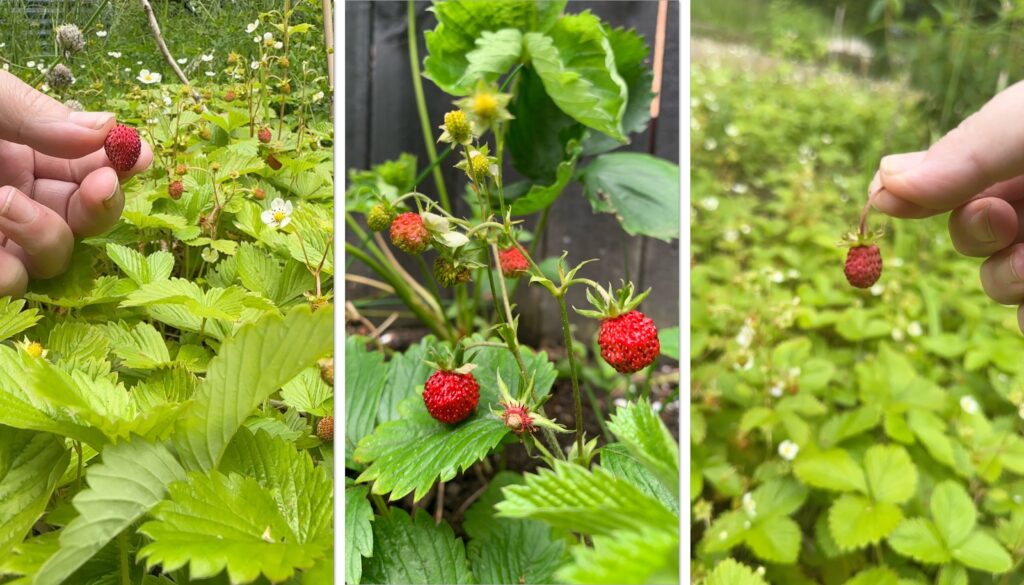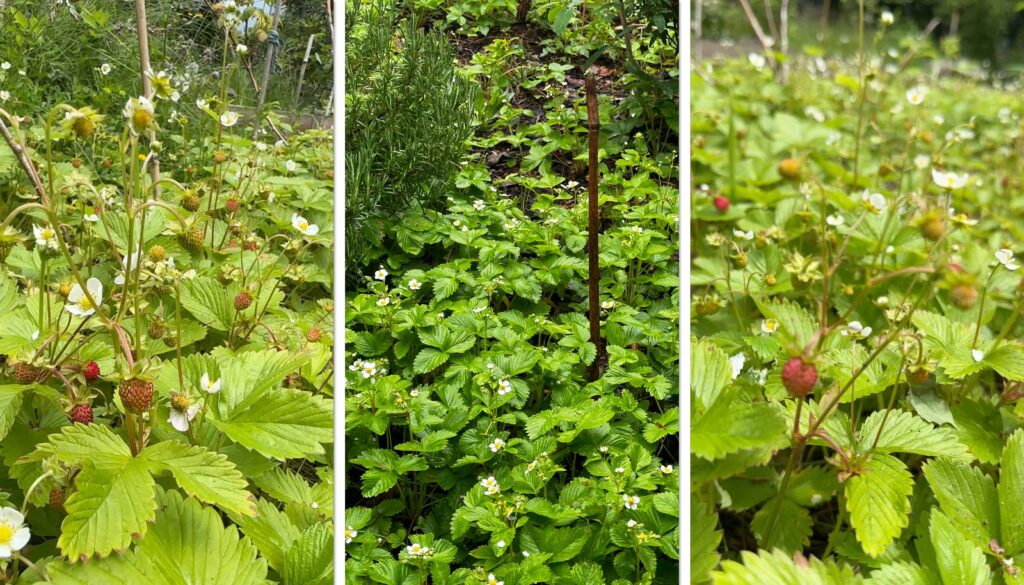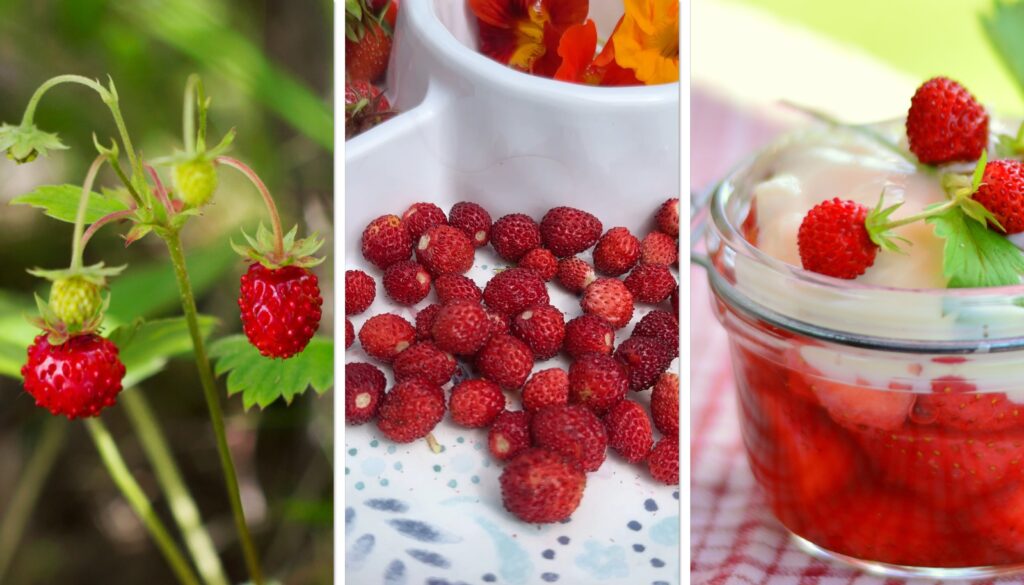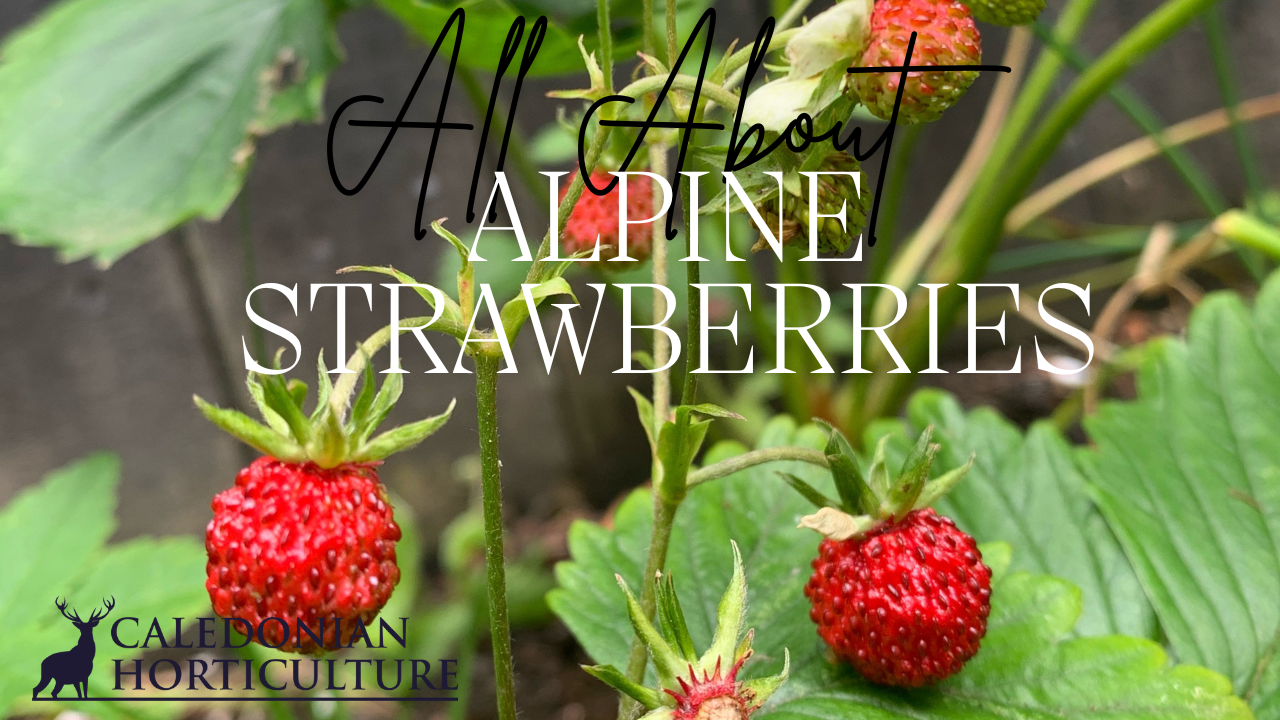Guest post by Katrina & Clayton
Growing Alpine Strawberries in the Scottish Climate
Alpine strawberries (Fragaria vesca), also known as wild or woodland strawberries, unlike larger cultivated varieties, alpine strawberries produce small, intensely flavourful fruits and are wonderfully adapted to cooler, temperate climates. Their native range includes much of Europe, including Britain, meaning they are well suited to Scotland’s often wet, breezy and mild conditions.
These plants are hardy perennials and grow low to the ground, typically forming dense mats of foliage that help suppress weeds and stabilise soil. They are ideal for underplanting, edges of paths, forest gardens, orchards and even container gardening. Alpine strawberries flower in Spring and early Summer, with fruit ripening from June onwards. While their fruit is smaller than modern varieties, their flavour is more concentrated making them perfect for snacking, adding to yoghurts, desserts, smoothies and salads.
The fruit, small, ruby red berries packed with rich, sweet flavour are ready for picking in early to mid Summer and are best eaten immediately after harvesting, as they’re highly perishable. Their intense delicate texture makes them perfect for desserts, jams, syrups and even herbal teas.
The leaves of alpine strawberry plants are also edible and can be used to make a mild, pleasant herbal tea. Pick the younger, tender leaves in Spring or early Summer, either fresh or dried. Strawberry leaf tea has traditionally been used as a digestive tonic and is high in vitamin C.
The flowers, although tiny, are also edible and can be used sparingly as garnish in salads or drinks. Their mild flavour and delicate appearance add visual interest to foraged dishes.

Planting Alpine Strawberries
Planting alpine strawberries in Scotland should ideally be done in early Spring or Autumn. Both seasons provide mild temperatures and moist conditions which are ideal for establishing young plants. You can start from seed, although germination is slow and can be erratic. For faster results, use bare root plants or plugs from reputable nurseries or propagate your own via runners.
Choose a spot that gets partial to full sun. Alpine strawberries will grow happily beneath fruit trees, mimicking their natural woodland habitat.
Prepare the soil by removing weeds and enriching it with compost or leaf mould. Plant each crown so the central growing point is level with the soil surface. Space plants around 20–30 cm apart, allowing them to spread naturally over time. Water thoroughly after planting and mulch to retain moisture and suppress weeds.
Pruning Alpine Strawberries
Pruning alpine strawberries is simple and generally involves tidying the plants at the end of the growing season. After fruiting, trim back old leaves in late Summer or early Autumn. This not only improves airflow and reduces the risk of disease but also encourages new growth before Winter.
In Spring, remove any dead or damaged foliage that hasn’t died back naturally. This encourages healthy growth and ensures the plant directs its energy into flower and fruit production. Unlike larger commercial strawberries, alpine strawberries don’t need aggressive pruning. Their low growing nature and light structure mean a gentle tidy up once or twice a year is sufficient.
Removing runners is optional. If you want your patch to expand, allow runners to root and form new plants. If you’re looking to contain their spread, snip off runners as they appear during the growing season. These can be potted up for propagation or composted.

Dividing Alpine Strawberries
Alpine strawberries don’t require dividing in the same way as herbaceous perennials, but they can be thinned or lifted and replanted if the patch becomes overcrowded or if you want to rejuvenate older plants.
The best time to do this is in Autumn or early Spring when plants are dormant or just beginning to grow. Gently lift established clumps and separate young, healthy crowns from older central growth. Replant the younger divisions with good spacing in fresh soil, preferably enriched with compost. Water them in well and keep them moist while they re-establish.
This method of renewing your strawberry patch helps maintain vigorous growth and can extend the productivity of your alpine strawberry bed for many years.
Caring for Alpine Strawberries
Caring for alpine strawberries is low effort. These hardy plants ask for little but will thrive with a bit of attention.
Watering is important during dry periods, especially in early summer when the fruit is forming. Although Scotland’s rainfall is usually sufficient, raised beds or sandy soils may dry out more quickly. Consistent moisture leads to plumper, juicier fruit.
Mulching helps in multiple ways, conserving soil moisture, suppressing weeds, and keeping developing fruit off the soil surface, which can reduce spoilage and slug damage. Use straw, leaf mould or well rotted compost around the plants in early Spring.
Alpine strawberries are relatively disease resistant, though good airflow and clean up of old foliage helps prevent fungal problems.
Companion Planting with Alpine Strawberries
Alpine strawberries work well as ground cover beneath taller crops and trees, making them excellent candidates for permaculture or forest garden systems. Their low growing, spreading nature helps retain moisture and suppress weeds, benefiting neighbouring plants.
Good companions include:
Borage: Attracts pollinators and improves flavour in strawberries.
Chives or garlic: Their strong scent may help deter pests like aphids and vine weevils.
Lettuce and spinach: Shallow rooted and fast growing, these won’t compete and can fill gaps between strawberry plants.
Fruit trees: Alpine strawberries make an excellent underplanting for apples, plums, or pears, particularly in more open orchard layouts.
Avoid planting them too close to potatoes or brassicas, which may outcompete them for nutrients or harbour pests and diseases not ideal for strawberries.

Raised beds, containers, or woodland style planting under trees with dappled shade can mimic the plant’s natural habitat. If your garden soil is poor, start alpine strawberries in pots with a peat free multi purpose compost mixed with sharp sand for better drainage.
Whether you’re planting them as a productive ground cover, incorporating them into a forest garden, or tucking them along the edge of a path, alpine strawberries bring beauty, biodiversity and are a delicious treat to add to your bowl.
Katrina & Clayton

Katrina & Clayton live with their family in East Ayrshire in Scotland and share their daily life in the garden on instagram @buildingfoodforest_scotland. They practice permaculture principles, reducing & repurposing waste whenever they can. Katrina shows how home educating in nature has helped Clayton thrive.
Clayton Completed The Grow and Learn Course with the Royal Caledonian Horticultural Society in 2022. This year he will be completing Level 2 Nurture Course. Clayton is 16, Autistic, Non Verbal & has been Home Educated for the last 6yrs. Both Katrina and husband Peter have studied the Permaculture Design Course PDC and PDC Pro over the last 5yrs, developing their garden from grass to an ongoing food forest.
They have featured on BBC Beechgrove Gardens, Gardeners World Magazine and write for Scotland Grows Magazine. Katrina has a series of children’s story books out following the life of Clayton in the garden. Available at Amazon.
See more and follow Katrina & Clayton at the links below:
-
 Builder’s Bag Planter Mix£79.00 inc VAT
Builder’s Bag Planter Mix£79.00 inc VAT -
 Builder’s Bag Kelpie Compost£72.00 inc VAT
Builder’s Bag Kelpie Compost£72.00 inc VAT -
 Builder’s Bag Green Goodness£52.00 inc VAT
Builder’s Bag Green Goodness£52.00 inc VAT

